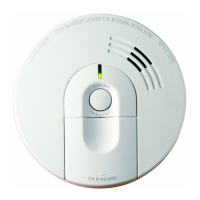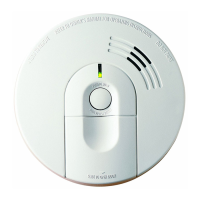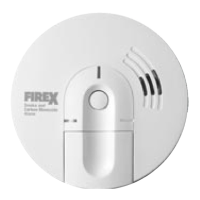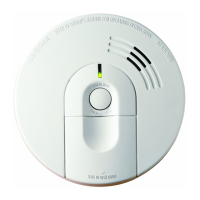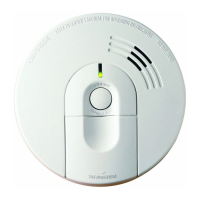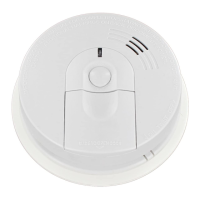1
110-1124D
SERIES 12000 IONIZATION SMOKE /
CARBON MONOXIDE ALARM
MODEL FADCM (12000 Series): 120 V AC WITH 9V BATTERY
BACK-UP
MODEL FADCM-B (12200 Series): DC ONLY WITH 9V BATTERY
MODEL GCM (12400 Series): 120 V AC ONLY
PLEASE READ AND SAVE THIS ENTIRE MANUAL
Installer: Please leave this manual with the product
Single or multiple station Smoke/CO alarm
Electrical rating Models FADCM and GCM: 120V AC, 60Hz, 0.06amp
Model FADCM includes 9V battery back-up
Single station Smoke/CO alarm
Model FADCM-B includes 9V battery
TABLE OF CONTENTS
About This Combination Alarm . . . . . . . . . . . . . . . . . . . . . . . . . . . . . . . . . . . . . . . .1
Specifications and Important Product Information . . . . . . . . . . . . . . . . . . . . . . . .1
Where to Install This Smoke/CO Alarm . . . . . . . . . . . . . . . . . . . . . . . . . . . . . . . .2-3
How To Install This Smoke/CO Alarm . . . . . . . . . . . . . . . . . . . . . . . . . . . . . . . . . . .4
1. Battery Power (DC) and DC Interconnect . . . . . . . . . . . . . . . . . . . . . . . . . . .4
2. Installing an AC With Battery Back-Up Alarm . . . . . . . . . . . . . . . . . . . . . . . .4
3. Interconnecting AC Only and AC/DC Alarms . . . . . . . . . . . . . . . . . . . . . . . .5
4. Installing as Replacements with Interconnected Legacy FireX Alarms . . . . .5
If the Alarm Sounds . . . . . . . . . . . . . . . . . . . . . . . . . . . . . . . . . . . . . . . . . . . . . . . . . .6
Chart : Understanding the LED Lights and Horn Patterns . . . . . . . . . . . . . . .7 & 8
Troubleshooting the CO Alarm . . . . . . . . . . . . . . . . . . . . . . . . . . . . . . . . . . . . .7 & 8
Important Safety Information . . . . . . . . . . . . . . . . . . . . . . . . . . . . . . . . . . . . . . . . . .9
Symptoms of CO Poisoning and Sources of CO in the Home
Testing and Maintenance . . . . . . . . . . . . . . . . . . . . . . . . . . . . . . . . . . . . . . . . . . . .10
Service and Warranty Information . . . . . . . . . . . . . . . . . . . . . . . . . . . . . . . . . . . . .10
About this Smoke/Carbon Monoxide Alarm:
This combination Smoke/CO alarm is designed to detect smoke and carbon monox-
ide gas. It is NOT designed to detect fire or any other type of gas. If this Smoke/CO
alarm sounds its alarm horn, DO NOT assume that it is a false alarm. The alarm
horn requires your immediate action.
WARNING
Individuals with medical problems may consider using warning devices which provide
audible and visual signals for carbon monoxide concentrations under 30ppm.
SPECIFICATIONS AND IMPORTANT PRODUCT INFORMATION
Product Features
• Monthly Self-Test: Approximately every 30 days this alarm performs a silent
internal system test to verify sensor operation utilizing True Gas Testing. True Gas
Testing assesses the service life of the CO sensor. Traditional CO alarms test the
sensor by simulating an alarm condition electrically. This is the first CO sensor that
runs a diagnostic test by generating a very small and harmless amount of hydro-
gen gas. If the sensor is working properly, it WILL NOT chirp. If the alarm chirps
during the monthly self-testing, it is indicating a problem with the unit. Refer to the
charts on pages 7 and 8 for the appropriate actions to take should this occur. You
must still test the alarm weekly to verify proper horn operation.
• Trigger Alarm Locator™ (TAL™): Most interconnect tests trigger all alarm horns
simultaneously for the duration of the test. This unique system alternates between
a 10 second ALL ON cycle and a 50 second cycle where only the initiating alarm
is sounding.
• Alarm Controlled Interconnect Test: In an interconnected system, this feature
will alarm the local unit first, then quiet the local unit while the remote units alarm.
• Smart Quiet™ Low Battery 1: Allows the homeowners to silence the low battery
chirp for up to 10 hours, giving them time to go back to sleep and/or purchase a
fresh replacement battery.
• Smart Quiet™ Low Battery 2: Indicates the battery no longer has enough volt-
age to adequately protect in the event of a power outage or a battery-only instal-
lation. The Smart Quiet™ feature will no longer silence the chirp. THE BATTERY
MUST BE REPLACED IMMEDIATELY.
Required Power Supply
• Model FADCM requires constant 120-volt, AC power and a working 9-volt battery to
operate properly. The alarms WILL NOT work if AC power is not connected or has
failed or been interrupted for any reason and in the case of FADCM, the battery is
removed, drained or improperly connected. DO NOT use any other kind of battery
except as specified in this manual.
• Model GCM requires constant 120-volt AC power to operate properly.
• Model FADCM-B operates on battery power only. Having only one source of power is
less reliable than having two different power sources. If the battery is too weak to
power the alarm, or is removed from the alarm, the alarm will not protect you from haz-
ardous conditions within your home. Make sure a battery-only installation complies
with your local codes and regulations. Check with your local fire department or building
code enforcement department if you are unsure of rules.
NOTE: AC/DC alarms offer added protection in the event of a power failure or a
drained battery.
The following symbols identify the most important safety messages in
this manual.
DANGER
WARNING
CAUTION
When you see this symbol, be aware that if the
message is ignored, the hazard WILL result in
SEVERE bodily injury or death.
When you see this symbol, be aware that if the
message is ignored, the hazard CAN cause
SEVERE bodily injury or death.
When you see this symbol, be aware that if the
message is ignored, the hazard CAN or WILL
cause MINOR bodily injury.
